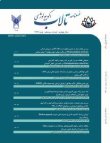Investigation photocatalytic removal efficiency of phenol in Shadegan pond by thin layer of titanium dioxide nanoparticles sensitized with natural pigments
Phenolic compounds, such as phenol, are found to be significant in agricultural and industrial wastewater, especially in petroleum and petrochemical industries. Since these industries make up a large share of foreign exchange earnings, we have ignored from the huge contamination of them. we produces a large amount of wastewater from these industries and dispossessed them without proper purification processes into rivers, ponds and seas. and cause Infect the environment. for example, the disposal of agricultural wastewater in Shadegan pond, such as the sugar cane development effluent, which it contains a wide range from phenolic compounds, including phenol, that it caused increase in phenol concentration up to 0.01-0.05μg/lit. due to the adverse effects on animals reproduction, it has reduced the populations of animal’s species in this pond. These contaminants enter to the human body through entering in the food cycle of aquatics. These compounds are highly resistant and cannot be purified through conventional processes, and they are causing severe pollution in surface waters and underground waters. According to the shortage of these resources in our country, preservation of these resources is the great importance. Therefore, it is important to study of the new Purification methods that can remove these pollutants from wastewater. Among the new methods, photocatalytic removal by the semiconductors sensitized with natural pigments has been considered due to high economic efficiency. In this study which began in 1395, the first investigated the sensitization of titanium dioxide with natural pigments, and then we described how to deposition layers of them on aluminum substrates that prevent from wasting of them, which they are models for future filters. After that, the optimal values for the four parameters that have the greatest effect on the reaction in the aqueous medium are calculated: the optimal concentration of pollutant is 20 ppm, the optimal concentration of adsorbent is 0.02 ppm, the optimal time is 120 min and the optimal pH is 3. and finally, we investigate the removal efficiency of phenol by the thin layer from nanoparticles of titanium dioxide sensitized with natural pigments in optimal conditions. These filters can remove other organic compounds such as hydrazine, Carbon Tetrachloride, ….
- حق عضویت دریافتی صرف حمایت از نشریات عضو و نگهداری، تکمیل و توسعه مگیران میشود.
- پرداخت حق اشتراک و دانلود مقالات اجازه بازنشر آن در سایر رسانههای چاپی و دیجیتال را به کاربر نمیدهد.


